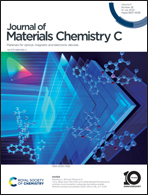Selective and non-selective modification of electrodes in organic thin film transistors by self-assembled monolayers†
Abstract
Modification of source and drain electrodes in organic thin film transistors (OTFTs) by dipolar self-assembled monolayers (SAMs) is frequently used to reduce the charge injection barrier at the interface between the electrodes and the organic semiconductor (OSC). However, such a modification can also affect the morphology and crystallinity of the OSC. Here, we show that the latter effect can be particularly strong and even decisive for the OTFT performance if the modification by SAMs not only involves the electrodes but, due to the specific affinity of the SAM-forming molecules, includes also the common OTFT substrate, usually exposed to these molecules as well, during the respective fabrication step. For this purpose, we fabricated and characterized in detail a series of model OTFTs with a top-gate-bottom-contact configuration and poly(3-hexylthiophene-2,5-diyl) OSCs. For the modification, we used binary dipolar SAMs with either carboxylic acid or silane anchoring groups, deposited either exclusively onto the electrodes (indium tin oxide) or both onto the electrodes and OTFT substrate (glass). The composition of the SAMs was varied, allowing us to tune the charge injection barrier gradually. The morphology and crystallinity of the OSC were monitored.



 Please wait while we load your content...
Please wait while we load your content...